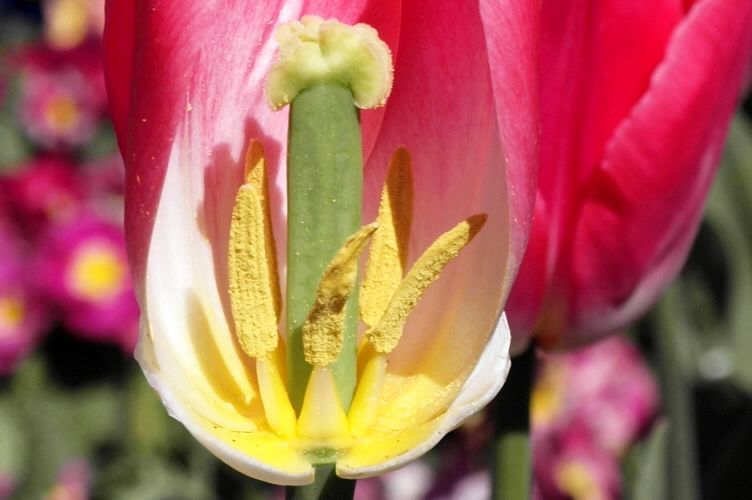Flowers are not on plants just to make them look pretty. They are there as a vital part of a flowering plant’s life cycle. Not all plants have flowers, find out what flowering plants are and how they are different to other plants.
Flowering plants create seeds, which get spread away from the parents and grow into new plants in new places. These seeds are part of the sexual reproduction of flowering plants. In this process, male cells combine with female cells, either on the same plant, leading to self-pollination, or between two plants of the same species, called cross-pollination.
Flowers have male and female structures, and it is the process of pollination that transfers pollen from the male part to the female part. After pollination, pollen releases a male gamete that fertilises a female gamete in the ovule and mixes their genetic material. After this fertilisation, the ovule grows to form a seed. This pollination and fertilisation article has more information.
Pollination has to happen before seeds can be made, so flowers have a range of ways to make sure it does. The male pollen cannot move to the female part of a flower on its own, so wind and animals are used to carry it instead. All the colours, shapes, sizes and smells of flowers are their ways of making it easy for the wind or animals to pick up and carry the pollen to the right female flower part.
Our resources will help you explore what pollination is, where it fits in the life cycle of flowering plants and some of the ways flowers try to make sure it happens.
Pollination in New Zealand ecosystems
Some flowers have such specialised structures that they can only be pollinated by a certain species of insect, bird or mammal. This is fine when an ecosystem is healthy, but if numbers of pollinators decline, this can have a knock-on effect on the plants and the ecosystem. Find out about some of the research New Zealand scientists are doing to investigate the effect the decline of native birds has on flowers that rely on them for pollination.
- Dr Mark Goodwin is head of the research team, Plant & Food Research, Ruakura and enjoys the challenges of working with pollination.
- Professor Dave Kelly is located at the School of Biological Sciences, University of Canterbury and is a population ecologist with a particular interest in pollination and the survival of native plants.
- Jenny Ladley has both a fascinating and, at times, frustrating role as a science technician and research assistant, at the School of Biological Sciences, University of Canterbury.
Fruit crops and pollination
Seeds are an important human food. Beans, lentils, peas, rice, nuts, sweetcorn, wheat, soybean and many other foods are all seeds. Many flowers also produce fruit to protect their seeds, and we eat these too. Apples, oranges, apricots, grapes, cucumbers, tomatoes and pumpkins and many more are fruit. As eaters, we call some of them vegetables, but to a botanist, they are all fruit.
A flower must be pollinated before it can make these seeds and fruit, and in some cases, more pollination means more seeds, which means bigger fruit. It seems that some fruit crops, such as kiwifruit and avocados, are not getting pollinated enough, and using our resources, you can discover what some New Zealand scientists are doing to investigate why. You’ll also find out about honey bees – the main pollinators of many cultivated food crops. In the case of kiwifruit, artificial pollination is often used to ensure good crops. Read about the RoboBee that is being developed to improve artificial pollination.
Take up the challenge
The student activities are designed to deepen understanding in two broad conceptual areas: pollination and fertilisation, and flowering plant life cycles.
Pass the pollen is a role-play activity in which students take on the role of flower parts and act out the process of insect pollination. Literacy is a strong feature in the other pollination and fertilisation activities: Pollination pairs (matching native flowers with their pollinators), Investigating pollen processing using evidence (interpreting and annotating diagrams) and Pollination – three-level teaching guide (locating and interpreting scientific information).
Let’s look at flowers uses hand-on observations of flowers to identify different parts of a flower and understand their functions. Plant parts relate commonly eaten foods to different parts of the flowering plant life cycle.
There is also a unit plan for lower primary students. It uses our pollination resources and the NZC levels 1 and 2 resources in Seeds, stems and spores – introduction.
Question bank
The Pollination – question bank provides an initial list of questions about pollination and places where their answers can be found. The questions support an inquiry approach.
Key terms
For explanations of key concepts, see Pollination – key terms.
Timeline
Explore the timeline to look at how scientists have changed their ideas about the importance of bird pollination in New Zealand.
Our annual inquiry for 2016 was about our local resources. The senior room (years 4-8) used the Science Learning Hub before and after we visited a local bee farm to study apiculture. Our students used the site's information and images at the initial inquiry stage. We visited the farm and students used the site again to check on what they did not know.
Aroha Gaylor, teaching principal
The next step was to inquire about pollination and the biology of plants. The year 7 and 8 students used Hub information in a collaborative way and presented their inquiry through a Google Docs platform. The Year 4 and 5 students formulated rich questions and researched them with the teacher. This is a great resource.
Planning pathways
Realistic contexts connect students to authentic scientific processes and purposes. It’s all explained in Pollination resources – planning pathways.



